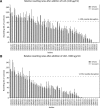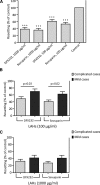Low anticoagulant heparin disrupts Plasmodium falciparum rosettes in fresh clinical isolates
- PMID: 21363975
- PMCID: PMC3042813
- DOI: 10.4269/ajtmh.2011.10-0256
Low anticoagulant heparin disrupts Plasmodium falciparum rosettes in fresh clinical isolates
Abstract
The binding of Plasmodium falciparum parasitized erythrocytes to uninfected erythrocytes (rosetting) is associated with severe malaria. The glycosaminoglycan heparan sulfate is an important receptor for rosetting. The related glycosaminoglycan heparin was previously used in treatment of severe malaria, although abandoned because of the occurrence of severe bleedings. Instead, low anticoagulant heparin (LAH) has been suggested for treatment. LAH has successfully been evaluated in safety studies and found to disrupt rosettes and cytoadherence in vitro and in vivo in animal models, but the effect of LAH on fresh parasite isolates has not been studied. Herein, we report that two different LAHs (DFX232 and Sevuparin) disrupt rosettes in the majority of fresh isolates from Cameroonian children with malaria. The rosette disruption effect was more pronounced in isolates from complicated cases than from mild cases. The data support LAH as adjunct therapy in severe malaria.
Figures



References
-
- World Health Organization . World Malaria Report. Geneva, Switzerland: World Health Organization; 2008.
-
- Kaul DK, Roth EF, Jr, Nagel RL, Howard RJ, Handunnetti SM. Rosetting of Plasmodium falciparum-infected red blood cells with uninfected red blood cells enhances microvascular obstruction under flow conditions. Blood. 1991;78:812–819. - PubMed
-
- Treutiger CJ, Hedlund I, Helmby H, Carlson J, Jepson A, Twumasi P, Kwiatkowski D, Greenwood BM, Wahlgren M. Rosette formation in Plasmodium falciparum isolates and anti-rosette activity of sera from Gambians with cerebral or uncomplicated malaria. Am J Trop Med Hyg. 1992;46:503–510. - PubMed
Publication types
MeSH terms
Substances
LinkOut - more resources
Full Text Sources
Other Literature Sources
Medical

